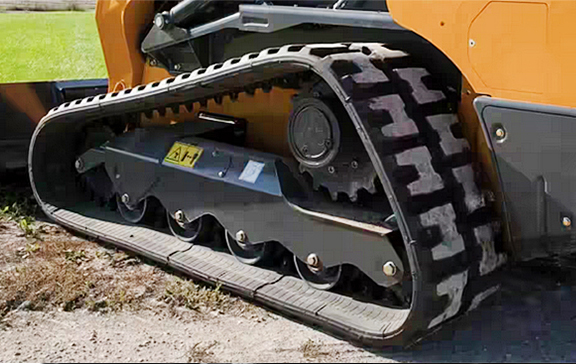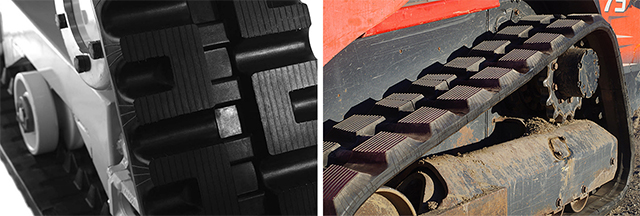Rubber tracks are essential components that provide stability, traction, and longevity to your skid steer loader. If you own compact equipment and want to replace or install new rubber tracks, you are at the right place. This comprehensive guide will walk you through installing them, highlighting essential factors to consider and providing detailed steps for successful completion. Read on to learn everything about equipping your machine for your application to ensure high performance and safety and reduce the chances of mishaps.
How Long Do Rubber Tracks Last on a Skid Steer?
Skid steer rubber tracks are designed to withstand the rugged conditions of construction work, landscaping projects, and other applications. However, their longevity depends on the following factors:
- The Hardness of the Surface On-Site – The terrain on which you operate your machine plays a significant role in the lifespan of the rubber tracks. Working on rough, abrasive surfaces such as concrete or gravel can accelerate wear and tear. Softer surfaces like grass or soil are generally gentler on the tracks, resulting in a longer lifespan.
- Operator’s Skills and Knowledge – How you handle your skid steer also affects the longevity of the rubber tracks. The smooth and controlled operation helps minimize unnecessary stress and wear on them. Abrupt maneuvers, excessive spinning, and aggressive turns can put undue strain on them, often reducing their lifespan.
How Tight Should Skid Steer Rubber Tracks Be?
Proper tensioning of the rubber tracks is crucial for optimal performance, efficiency, and longevity. Failing to do so can cause various problems, such as fractured idlers, accumulated materials in the undercarriage, and more. On most machines, you can adjust it by putting or taking out the grease from a cylinder.
- Pouring grease into the cylinder will drive the sprocket apart and push the front idlers. The rubber tracks should be tight enough to prevent excessive sagging or slippage during operation.
- Taking some out will help reduce the tension. The tracks should not be overly tight, as it can strain the undercarriage components and potentially damage the machine.
How loose or tight you run your track depends on the ground conditions.
- When operating your skid steer in the sand, you may loosen the tension on the track to minimize the wear and tear on its metal embeds and sprocket.
- Set the tracks tighter when working on rocky terrain to avoid debris and stones.
- Be sure to modify the tension according to the ground conditions and your application.
Check your skid steer’s manual or the manufacturer’s recommendations for the specific tensioning requirements. In addition, consult an expert immediately for correct instructions if the track falls off.
10 Steps to Install Skid Steer Rubber Tracks
Now that we understand the factors influencing the lifespan of rubber tracks and the importance of proper tensioning, here is the step-by-step process of installing them on your compact equipment:
Step 1: Be Well Prepared
Before starting the installation process, gathering all the necessary tools and equipment is crucial. Ensure you have the appropriate replacement rubber tracks for your skid steer. Read and understand the installation instructions provided by the manufacturer.
Step 2: Lift the Machine
Use a reliable lifting device to raise the skid steer off the ground. Ensure it is securely supported to prevent accidents or damage during installation.
Step 3: Empty the Grease Cylinder
Release the pressure in the grease cylinder by removing the valve or loosening the fitting. Allow it to fully retract before proceeding.
Step 4: Remove the Old Tracks
Carefully detach the existing rubber tracks from the skid steer, starting from one side. Adhere to the specific guidelines provided by the manufacturer for track removal.
Step 5: Check the Undercarriage Parts
Inspect the undercarriage components for any signs of damage or wear. Replace worn-out or damaged parts to ensure optimal performance and prevent problems with the new rubber tracks.
Step 6: Replace the Sprocket
Remove the old sprocket and replace it with a new one if necessary. Ensure the teeth align correctly with the rubber tracks for smooth operation.
Step 7: Install the New Tracks
Begin by positioning the new rubber tracks onto the undercarriage. Ensure that the drive lugs align with the sprocket teeth. Follow the manufacturer’s advice on adequately aligning them and engaging the lugs with the sprocket. It is crucial to ensure a secure and proper fit for optimal performance.
Step 8: Refill the Grease Cylinder
Once you secure the tracks, refill the grease cylinder with the appropriate lubricant. Greasing the undercarriage components helps reduce friction and ensures smooth operation. Check the machine’s manual for the recommended grease type and quantity.
Step 9: Check the New Track
Before lowering the skid steer, take a moment to inspect the replaced track for proper alignment and tension. Ensure it is properly seated and tensioned. You may need to adjust for optimal tension for reliable performance and longevity.
Step 10: Replace the Other Rubber Track If Necessary
It is recommended to replace both rubber tracks at the same time to maintain uniformity and balance and ensure consistent performance. Repeat the same steps to install the track on the other side of the skid steer.
By following these steps and ensuring proper tensioning, you can optimize the performance and enhance the lifespan of your tracks, allowing for efficient operation on various terrains.
Get High-Quality Skid Steer Rubber Tracks for All Models
At Tag Equipment, we offer a wide variety of durable and reliable rubber tracks, including Camso rubber tracks, rubber tracks for mini excavators, carriers, dumpers, and paver rubber tracks.
We feature products for all makes and models of skid steers, including Bobcat, CAT, Case, Gehl, John Deere, Yanmar, Takeuchi, Kubota, Volvo, and more.
Our selection comprises rubber tracks by the following major brands:
- Traxter Tracks
- Camso Rubber Tracks
- ITA America Tracks
For more product information, warranty details, and prices, call us at 416-716-5850. You may also fill out the requirements in the online inquiry form to contact us. We will ensure you equip your machine with the best parts and attachments to achieve the desired performance.
Also Read: HOW TO INSTALL REPLACEMENT RUBBER TRACKS FOR YOUR MACHINE


